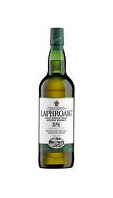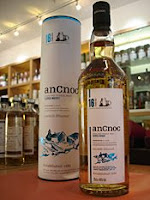 Laphroaig (pronounced la-froyg) is one of the most famous distilleries in the world and is located on the western island of Islay. The distillery was founded in 1815 and has been the best selling smoky malt worldwide for the last six years. Laphroaig is currently owned by Beam Global, who are one of the world's largest spirits companies, and has a capacity of around 2.5 million litres a year. At Laphroaig they produce some of the peatiest smoky whiskies in the world and this is achieved by drying the malted barley over a peat fuelled fire for a longer period than at most distilleries - 18 hours. Over this time much of the acrid smoke gets absorbed into the barley grains and this gets carried through the whole distillation process.
Laphroaig (pronounced la-froyg) is one of the most famous distilleries in the world and is located on the western island of Islay. The distillery was founded in 1815 and has been the best selling smoky malt worldwide for the last six years. Laphroaig is currently owned by Beam Global, who are one of the world's largest spirits companies, and has a capacity of around 2.5 million litres a year. At Laphroaig they produce some of the peatiest smoky whiskies in the world and this is achieved by drying the malted barley over a peat fuelled fire for a longer period than at most distilleries - 18 hours. Over this time much of the acrid smoke gets absorbed into the barley grains and this gets carried through the whole distillation process.The core range from the distillery consists of two 10 year olds (one of which is cask strength), this 18 years old, a 25 years old and a quarter cask (which is matured in smaller casks). This 18 years old has recently replaced a 15 years old in the range and has just been released in the UK. Other limited edition distillery bottlings are released occasionally but are normally extremely pricy. Laphroaig is also popular with independent bottling companies and readily available.
The colour of this Laphroaig 18 years old is a rich golden yellow and the nose is fresh and clean with an instant hit of pungent aromatic smoke. This smokiness is earthy (imagine damp moss and dry peat) and balances with other elements such as vanilla, a briny saltiness and a touch of honey. On the palate, it is robust and powerful. It offers early sugary sweetness that combines the vanilla and honey from the nose again, as well as malty cereal grains and a nice slightly spicy woodiness. This is balanced almost perfectly by the smokiness (less earthy and more like charcoal or burning embers/ash this time), some more saltiness (think of brine) and a bitter twist (imagine iodine). The finish is lovely and very long with a bittersweet mix of vanilla, honey, warm spices (think of a hint of ginger) and a pronounced bitter smokiness (now reminding us of creosote fence paint).
The Laphroaig 18 years old is excellent and is a welcome and complimentary addition to Laphroiag’s core range of whisky. It is bottled at 48% ABV which allows the whisky to express itself fully. It has a tough job to replace the classic and popular 15 years old (one of our favourite drams ever) but it copes well. A bottle should cost around £65 from selected specialist whisky retailers.
* The image in this post is temporary and will be replaced with a regular image shortly.*


















